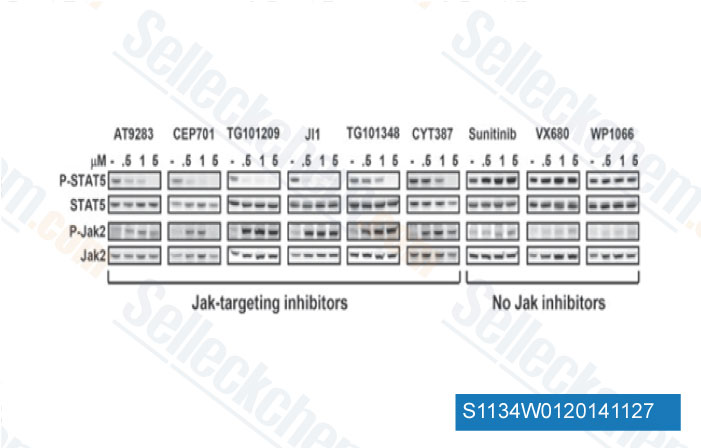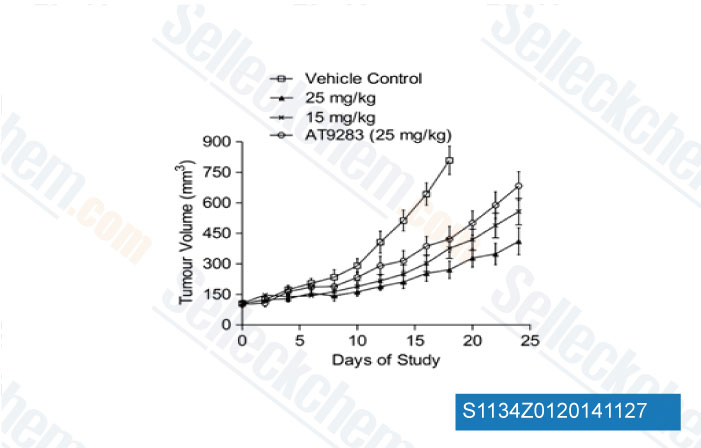|
Toll Free: (877) 796-6397 -- USA and Canada only -- |
Fax: +1-832-582-8590 Orders: +1-832-582-8158 |
Tech Support: +1-832-582-8158 Ext:3 Please provide your Order Number in the email. |
Technical Data
| Formula | C19H23N7O2 |
|||
| Molecular Weight | 381.43 | CAS No. | 896466-04-9 | |
| Solubility (25°C)* | In vitro | DMSO | 76 mg/mL (199.25 mM) | |
| Ethanol | 25 mg/mL (65.54 mM) | |||
| Water | Insoluble | |||
|
* <1 mg/ml means slightly soluble or insoluble. * Please note that Selleck tests the solubility of all compounds in-house, and the actual solubility may differ slightly from published values. This is normal and is due to slight batch-to-batch variations. * Room temperature shipping (Stability testing shows this product can be shipped without any cooling measures.) |
||||
Preparing Stock Solutions
Biological Activity
| Description | AT9283 is a potent JAK2/3 inhibitor with IC50 of 1.2 nM/1.1 nM in cell-free assays; also potent to Aurora A/B, Abl1(T315I). | |||||||||||
|---|---|---|---|---|---|---|---|---|---|---|---|---|
| Targets |
|
|||||||||||
| In vitro | AT9283 leads to a clear polyploid phenotype by inhibiting the activity of Aurora B kinase in HCT116 cells with IC50 of 30 nM. Furthermore, AT9283 also produces the potent inhibition on HCT116 colony formation. [1] |
|||||||||||
| In vivo | In HCT116 human colon carcinoma xenograft bearing mice, AT9283 treatment (15 mg/kg and 20 mg/kg) for 16 days results in a significant tumor growth inhibition of 67% and 76%, respectively. In addition, AT9283 also exhibits a significantly longer half-life in tumors(2.5 hours) compared with plasma (0.5 hour) and modest oral bioavailability in mice (Fp.o. = 24%). [1] |
Protocol (from reference)
| Kinase Assay: |
|
|---|---|
| Cell Assay: |
|
| Animal Study: |
|
References
|
Customer Product Validation

-
Data from [Data independently produced by J Cell Mol Med, 2013, 17(2), 265-76]

-
Data from [Data independently produced by Drug Development Reseach, 2013, 272-281]

-
, , Dr. Claude Haan and Catherine Rolvering of Universite du Luxembourg
Selleck's AT9283 has been cited by 36 publications
| Molecular basis of JAK kinase regulation guiding therapeutic approaches: Evaluating the JAK3 pseudokinase domain as a drug target [ Adv Biol Regul, 2025, 95:101072] | PubMed: 39755448 |
| DLGAP5 promotes lung adenocarcinoma growth via upregulating PLK1 and serves as a therapeutic target [ J Transl Med, 2024, 22(1):209] | PubMed: 38414025 |
| Regulation of Cell Cycle Progression through RB Phosphorylation by Nilotinib and AT-9283 in Human Melanoma A375P Cells [ Int J Mol Sci, 2024, 25(5)2956] | PubMed: 38474202 |
| Selective impact of ALK and MELK inhibition on ERα stability and cell proliferation in cell lines representing distinct molecular phenotypes of breast cancer [ Sci Rep, 2024, 14(1):8200] | PubMed: 38589728 |
| The Aurora kinase inhibitor AT9283 inhibits Burkitt lymphoma growth by regulating Warburg effect [ PeerJ, 2023, 11:e16581] | PubMed: 38099309 |
| Selective Impact of ALK and MELK Inhibition on ERα Stability and Cell Proliferation in Cell Lines Representing Distinct Molecular Phenotypes of Breast Cancer [ bioRxiv, 2023, 10.1101/2023.12.19.572304] | PubMed: none |
| Inhibition of IκB Kinase Is a Potential Therapeutic Strategy to Circumvent Resistance to Epidermal Growth Factor Receptor Inhibition in Triple-Negative Breast Cancer Cells [ Cancers (Basel), 2022, 14(21)5215] | PubMed: 36358633 |
| PERV induces CXCL10 in human monocytes and monocyte-derived primary cells [ Intervirology, 2022, 10.1159/000527074] | PubMed: 36382641 |
| Establishment and characterization of immortalized sweat gland myoepithelial cells [ Sci Rep, 2022, 12(1):7] | PubMed: 34997030 |
| Phenotypic Screening for Small Molecules that Protect β-Cells from Glucolipotoxicity [ ACS Chem Biol, 2022, 10.1021/acschembio.2c00052] | PubMed: 35439415 |
RETURN POLICY
Selleck Chemical’s Unconditional Return Policy ensures a smooth online shopping experience for our customers. If you are in any way unsatisfied with your purchase, you may return any item(s) within 7 days of receiving it. In the event of product quality issues, either protocol related or product related problems, you may return any item(s) within 365 days from the original purchase date. Please follow the instructions below when returning products.
SHIPPING AND STORAGE
Selleck products are transported at room temperature. If you receive the product at room temperature, please rest assured, the Selleck Quality Inspection Department has conducted experiments to verify that the normal temperature placement of one month will not affect the biological activity of powder products. After collecting, please store the product according to the requirements described in the datasheet. Most Selleck products are stable under the recommended conditions.
NOT FOR HUMAN, VETERINARY DIAGNOSTIC OR THERAPEUTIC USE.
